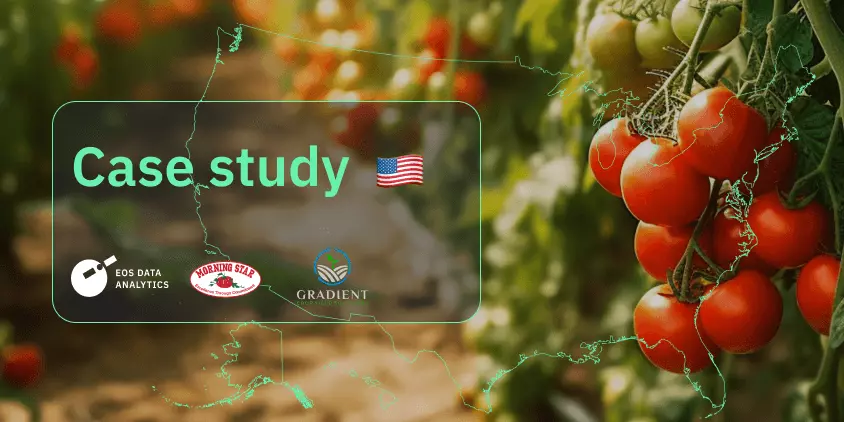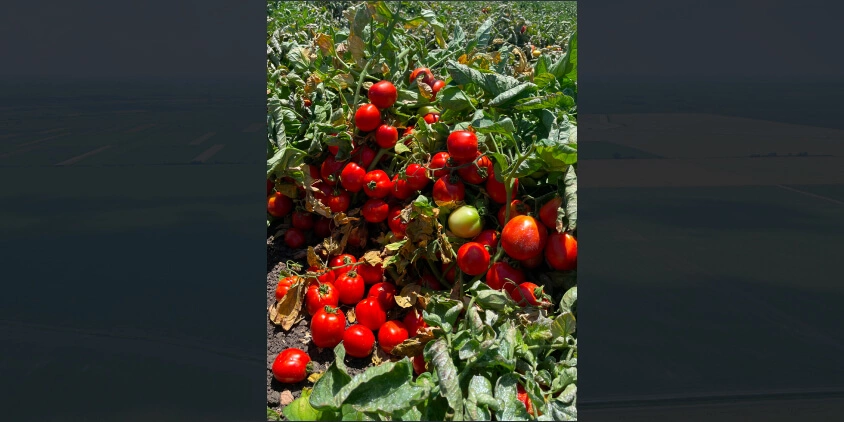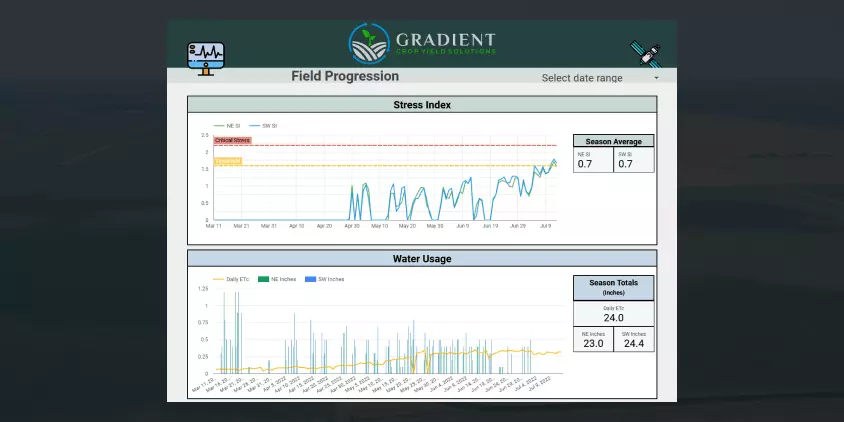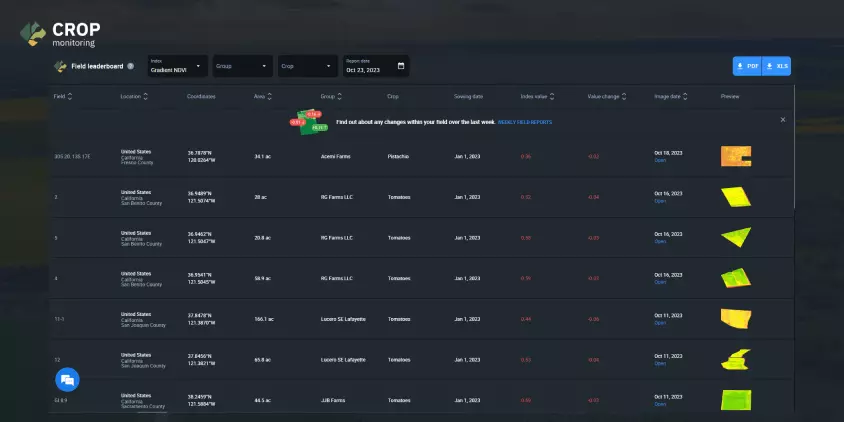
The Morning Star’s Gradient Implements Remote Sensing
Growing tomatoes in California, despite its favorable climate, presents several agricultural challenges. Tomato cultivation in this region is significantly impacted by water scarcity, with inconsistent irrigation management leading to crop yield loss and impacted plant health. Soil degradation resulting from intensive agricultural practices presents challenges for successful tomato production, too. Meanwhile, on a global scale, climate change results in unpredictable weather patterns like heatwaves, heavy rains, and wildfires, posing challenges for maintaining optimal tomato cultivation conditions .
To navigate these challenges, producers often rely on weather forecasts and soil samples to guide their management decisions. However, recent years have witnessed the rise of modern technology such as multispectral satellite imagery analytics. One notable industry leader that has embraced this evolutionary movement is The Morning Star company, the largest tomato processor in the world. In this case study, we will explore their decision to utilize EOSDA Crop Monitoring, and how this new practice is revolutionizing the future of agriculture.
Overview: About The Morning Star Company
The Morning Star company was founded in 1970 by Chris Rufer as a small owner-operator tomato hauling business in California’s Central Valley. Today, the company has become the world’s largest tomato processor, operating three factories dedicated only to tomatoes. The Morning Star Company supplies more than 40% of the national market with diced tomatoes and ingredient tomato paste for food manufacturers, retailers, and food services, having achieved global recognition in the tomato industry by leading innovative changes in production technology that have increased efficiency throughout the sector.
Despite the company’s significant expansion, The Morning Star Company has maintained its core values of producing high-quality tomato products, ensuring that customer service expectations are met, and operating in an environmentally conscious manner. The Morning Star Company’s products generate more than $800 million in annual sales. Notably, the company continues Chris Rufer’s commitment to haul its tomatoes from the fields to the processing plant, a practice it has consistently maintained for over 50 years.
Currently, The Morning Star Company is servicing growers from the south to the north of California and throughout the Central Valley across a total area of about 112,000 acres.
Usually, the tomato growing season in California begins around mid-March, starting in Bakersfield, where the initial fields are planted. The process starts in Southern California and gradually progresses northward, with some fields in Northern California being planted by April. Planting takes place on both sides, moving towards the middle and Stockton, which generally contains the last fields. This phase lasts until the end of June, with mid-June being the average completion time. Once July arrives, planting is rarely done as it is considered too late. The aim is to finish all planting by the beginning of July.
When it comes to harvesting, fields planted in March are typically harvested by July, representing a growth period of approximately 3 to 4 months. Fields planted in April are harvested in late August or September. The latest harvests occur in late October. As November approaches, there are usually no fields remaining for harvest.
Challenges: Over-Irrigation, Nutrition Deficiencies, Imagery Availability
Some of the issues, in this particular case, arise primarily due to the overuse of water in irrigation. Particularly on hot days, growers have a tendency to excessively water their crops, neglecting the fact that irrigation could be conserved if the plant’s water requirements are adequately met by the soil moisture content. By maintaining optimal volumetric water content in the soil, depending on its type, a consistent and sufficient water supply can be ensured, eliminating the need for unnecessary watering solely based on weather conditions.
Addressing this challenge is where the Gradient’s platform and system come into play. Through the utilization of precision agritech, growers can significantly improve their irrigation practices beyond relying solely on evapotranspiration or weather data.
Additionally, nutrient deficiencies, particularly in tomatoes, have emerged as another significant concern. As a result, Gradient has been working on developing an enhanced nutrition program to address this issue for growers. This ongoing effort represents an important step towards resolving this problem and ensuring healthier crops.
Finally, the frequency, quality, and cost of field imagery were one of the areas for improvement that Gradient was specifically tasked by The Morning Star company to explore.

Jesus Salcedo, Software Engineer at Gradient, began as a member of the R&D team in 2018, testing various technological means on the fields to improve irrigation practices and to see if they can improve yields and have better tomatoes using less water. By the time Jesus joined the team, they had already conducted numerous experiments since 2012, so in most cases, they knew exactly what sensors worked and what didn’t.
The last piece of technology missing, field imagery, was gaining popularity in 2018. As a result, Gradient’s R&D team started looking into the viability of acquiring crop health images using drones and satellites, then stitching, processing, and providing them in a platform as a source of visual analytics.
The newly created Gradient Crop Yield Solutions had significant success. The growers’ enthusiasm prompted the team to expand their trials in response to increasing demand, leading to the inception of Gradient as a stand-alone company in 2019.
To accommodate the increasing demand, Gradient’s team has been continuously working on enhancing its infrastructure and scaling up its operations. Although there have been numerous requests to open the program to additional fields and growers, they have been cautious about maintaining the quality of service during this expansion phase. In terms of aerial imagery, the team transitioned from drones to airplanes as they realized that drones were impractical for covering large acreages efficiently. However, the cost per acre for airplane imagery and revisit frequency (8 images a year) proved to be a limiting factor, prompting the team to explore more cost-effective options while maintaining a comparable resolution.
In 2022, I made a comparison of three technologies: drones, planes, and satellites and presented it to growers at one of our conferences. We found that all those sources were able to provide similar images and spot the same areas of concern. However, with satellites, we were getting almost three times as many images a season than airplanes and drones for a fraction of the cost. When combined with our platform that has in-ground sensor data, you have a very strong platform with eyes in the sky and eyes on the ground. The growers really liked the combination of both technologies. They are now able to understand how their fields are doing and how it is progressing day after day, week after week. So, now, we are providing them with access to both EOSDA Crop Monitoring and our platform and plan to expand by creating an all-in-one platform, where they will be able to perform crop monitoring, weeding, crop nutrition, valve automation, and pest management.
Now, Gradient’s mission is to provide growers with a comprehensive platform that integrates various technologies. Currently, only crop monitoring based on satellite imagery analytics is offered as a service but, laser weeding, crop nutrition, pest monitoring, and automated valve control are currently being researched and developed. The goal is to offer growers a unified platform that combines diverse technologies to streamline their operations. Initially, the focus was on irrigation monitoring, starting with 6,200 acres. The team’s success led to rapid expansion, reaching 12,000 acres in 2020 and further growing to 23,000 acres in 2022. The team aims to expand to approximately 26,000 acres in 2023 and is projecting further growth to 35,000 to 40,000 acres in subsequent years.
EOSDA Crop Monitoring
Offering high-resolution satellite images for fields analytics to monitor crops health remotely!
Solutions: Online Platform, Satellite Data, Scouting
The Gradient team currently operates a comprehensive platform designed explicitly for crop monitoring purposes. Their primary service revolves around setting up growers with a variety of sensors to assist with the irrigation decision-making process These include measurements such as volumetric water content, air temperature, relative humidity, and plant stress. Additionally, they acquire data on plant stress, which is combined with satellite imagery to evaluate the progress of fields throughout the growing season. Satellite images serve as a means to verify the data and assess field uniformity.

To illustrate, using the EOSDA Crop Monitoring and Gradient platform, the Gradient team examines the collected data to assess the field’s condition, identifying any indications of stress and monitoring the volumetric water content levels. By correlating the data received from ground sensors with NDVI values across the field, the team establishes correlations between similar sensor readings. For instance, if the sensors are positioned in light green or dark green areas, any other locations with comparable readings are likely to experience similar stress levels in the crops. This approach allows them to extrapolate the overall condition of the field based on the available data.
Satellite imagery allows us to be able to monitor these different areas without having to be there in the field. And if we spot any issues or concerns within the field, we can send a technician or alert the grower about the potential issues. It saves us from the need to consistently visit fields for checks that may not be necessary.
Growers have convenient access to EOSDA Crop Monitoring, where they can view in-depth data about their fields on a daily basis. Additionally, Gradient provides a comprehensive overview of the field conditions through the information presented on their platform. To facilitate satellite-powered data analysis, they offer a clickable link that directs growers to EOSDA Crop Monitoring, which opens in a separate browser tab. This allows growers the option to explore the imagery data associated with their fields should they choose to do so.

Analyzing field conditions remotely through satellite imagery provides growers with important insights. However, Gradient goes even further by offering a more personalized approach.
They employ field technicians who are responsible for monitoring and observing the conditions within their growers’ fields. These technicians are dispatched to assess the state of the fields and provide further analysis in fields that show high stress. Once their assessment is complete, they promptly inform the grower about any pertinent findings and offer necessary assistance to address the situation.
Typically, the platform team engages in direct communication and collaboration either with the growers themselves or the field managers responsible for overseeing the farms or ranches. They establish contact and training with the appropriate individuals to ensure effective communication. Monthly meetings with growers are standard practice, along with additional meetings as per their requests.
Even if growers do not encounter any specific issues or reach out, we proactively schedule meetings every two to three weeks to review the data, discuss field progress, and address any concerns. Our commitment to exceptional customer service is a source of pride for us, as we strive to maintain active involvement throughout the entire growing process, closely supporting the growers.

Furthermore, Gradient extends its services to assist new growers who may lack experience in growing tomatoes. Through their own platform, they provide guidance and insights, enabling growers to develop a solid understanding of tomato farming. Notably, Gradient has achieved remarkable success in collaborating with first-year growers. For instance, one of their growers, who was new to tomato farming in 2022, utilized the Gradient platform with EOSDA Crop Monitoring imagery and achieved an impressive yield of approximately 65 tons per acre at the end of the season. This outcome is particularly noteworthy for a first-time grower. One aspect that resonated with him was the platform’s value during a period when he sustained an injury, rendering him unable to be physically present in the fields for about a month and a half. He relied solely on the Gradient platform and the EOSDA Crop Monitoring images during this time, which provided him with accurate updates on the field’s status and affirmed that he was implementing correct practices. Witnessing the positive results at the end of the harvest, he expressed deep satisfaction, attributing his success to the platform’s indispensable contribution.
Results: Synergy Of Remote And Ground Sensors, Custom AI, Increased Acreage
The combined use of EOSDA Crop Monitoring and Gradient Crop Yield Solutions has helped Gradient save farmers 10-15% in irrigation costs, compared to grower-standard irrigation practices.
Salcedo also noted that assessing types of soil and their water-holding capacities using multispectral imagery has room for improvement. Usually, satellite imagery provides surface reflectance and soil moisture data but to perform the most accurate analysis, that needs to be complemented with precise measurements of the local soil architecture.
Open data sources providing information on soil types can contain inaccurate soil type classifications, which, according to Gradient’s experience, may not accurately reflect current soil compositions. Soils can change over time, and their characteristics may vary, including depth-related variations. For instance, publicly available soil maps, while indicating clay content, may fail to account for mixtures of clay and clay loam, influencing water retention capabilities, which may lead to mistakes in irrigation.
Considering that Gradient’s in-ground data collection typically captures plant behavior during peak stress periods, such as the hottest times of the day, combining this information with deep soil content modeling and satellite imagery featuring agri-specific wavelength bands proves highly valuable. This approach allows for evaluating photosynthetic activity, identifying stressed areas, and correlating them with specific yield outcomes, thereby enabling reliable predictions for future harvests.

As a result, Gradient aims to develop a solution that will seamlessly integrate ground and satellite data and provide growers with actionable insights. Those objectives are possible to achieve in quite a few ways, with EOSDA Crop Monitoring customization in the near future, and custom AI solutions in long-term plans.
EOSDA offers an indispensable resource for experienced soil scientists who possess their own research findings in digital elevation models and methods for the verification of soil prediction maps .
One of the ways to continue enhancing Gradient’s own platform is to visualize the locations of their in-ground sensors and the corresponding data. Additionally, they expressed enthusiasm for the potential of newly launched satellites, which are specifically designed for agricultural applications. These advanced satellites are expected to offer enhanced algorithms and insights. While there are no immediate plans for direct API integration into their platform, Salcedo showed interest in future possibilities. However, the current partnership with EOSDA involves expanding its operations and covering as many acres as possible.
The Gradient team has observed positive feedback from growers regarding the use of satellite images and provides thorough training to ensure they can effectively utilize the platform. Users appreciate the ability to access informative graphs, track plant vegetation curves based on average NDVI, examine acreage percentages, assess field zoning, and utilize other advanced features. These features notably encompass the field leaderboard and enhanced index options, which offer the flexibility of evaluating average indices either by specific hectare quantities in the field or as percentage values, providing a comprehensive overview of field conditions.
Gradient aims to continue the collaboration and foresees significant growth, with a long-term goal of expanding to hundreds of thousands of acres. They anticipate their partnership with EOSDA Crop Monitoring will also develop in tandem with its expanding operations.
About the author:
Karolina is currently pursuing a BSc at Pennsylvania State University. She excels in communicating the scientific value of EOSDA precision and sustainable solutions in an easy-to-read way. Karolina is a dedicated advocate for personal empowerment striving to represent and uplift Ukrainian women in the global STEM community. She’s a member of AWIS, WIT and other organizations.
Recent articles

Analyze 2025 & Plan Your Best Year Yet: LandViewer Christmas Offer
It’s the most wonderful time of the year! The Christmas holidays are here, and so is your chance to analyze 2025 and plan a prosperous 2026 with more affordable Pro plans in LandViewer.

EOSDA Models Climate Change Impact On Sugarcane Yields
EOSDA modeled future temperature, rainfall, and other climate impacts on Veracruz sugarcane. The results help growers plan long-term adaptation strategies, including timing, varieties, and irrigation.

EOSDA LandViewer Black Friday Sale: Exclusive Offers & Giveaway
This Black Friday, LandViewer offers new users the chance to save on monthly plans, get extra months with yearly subscriptions, and participate in a free annual plan giveaway.